By: U.S. Career Institute
April 2024
Remote work was far from the norm before 2020 and now, thanks to the pandemic pushing millions of people to figure out how to work from home, it’s much more common. Hybrid work has grown in popularity as workers want the best of both worlds, to have the freedom remote work offers as well as the social interactions from working in the office with coworkers.
Now that society is four years out from the beginning days of the pandemic, how many people are still working fully remote or hybrid work from home jobs? Read on to find the answer, along with a plethora of interesting and eye-opening facts and statistics about remote work in America and beyond.
Benefits of Remote Work
What are the benefits of remote work? Working remotely has proven to offer many benefits, for both the employees and the employers who have learned to embrace the new work from home way of life. The benefits of working from home range from mental and physical to financial. There are many benefits to remote work, the following list contains just some of the positives that employees and companies have discovered from working remotely.
-
Remote workers in the U.S. save an average of 55 minutes every day by not having to commute to work.
The worldwide average is 72 minutes in commute time saved every day; 40% of remote workers were found to use the time they saved working their primary, or even secondary, job.
-
Remote workers cut greenhouse gas emissions by up to 54% by not commuting to an office five days a week.
Compared to employees who commute to an office, remote workers are cutting emissions even if they only work from home one day per week. One day of remote work cut emissions by 2% while 2 to 4 days of remote work cut emissions up to 29%.
-
Remote workers say the top benefit of working from home is not having to commute to the office.
Remote workers were asked to choose the top 3 benefits of working from home and 59.65% selected “No commute” as the top benefit. Saving money on gas and lunch, and the flexibility over when they work were the second and third most chosen options.
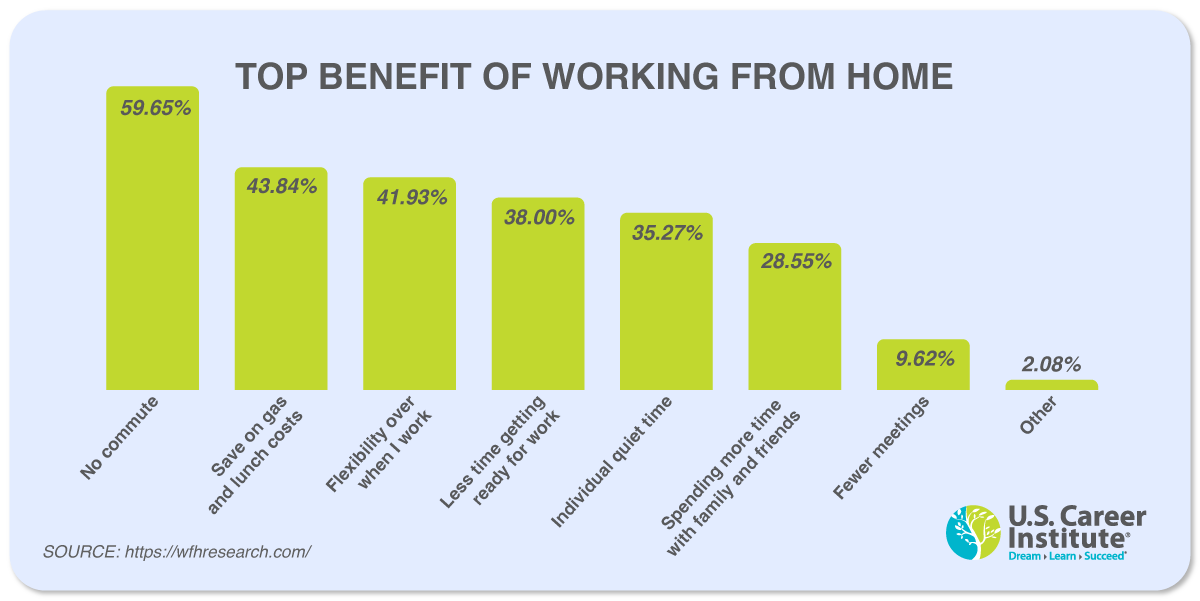
-
Remote workers enjoy the freedom to nap, exercise, or watch TV during the workday while working from home.
Of the remote employees surveyed, 72% want to be able to take a nap or exercise during the work day while 73% want to be able to watch TV while they work. Employees who work from home enjoy the freedom it allows them during the slower parts of their work day.
-
Companies can save up to $10,600 per employee that works remotely.
If companies decide to go remote they can save many thousands of dollars each year by not having to pay office rent, utilities, coffee, and other expenses like furniture and office supplies. A company with 50 employees could save half a million dollars annually just by going remote!
-
The average employee can save up to $12,000 per year by working remotely.
A hybrid worker who works remotely half of the time can save up to $6,000 each year, and a fully remote employee could see savings of up to $12,000 each year by not having to pay for things like gas, office clothes, and lunch.
-
Remote work can have a positive impact on an employee’s mental and physical health.
Nearly all working professionals surveyed agreed that working from home was good for their health; 93% agree that working remotely has had a positive impact on their mental health and 90% say that it has had a positive impact on their physical health.
-
The top health benefit of working from home is decreased stress.
48% of those surveyed said that less stress is one of the health benefits they experience from working remotely, followed by less burnout and healthier food choices to round out the three top health benefits of working from home.
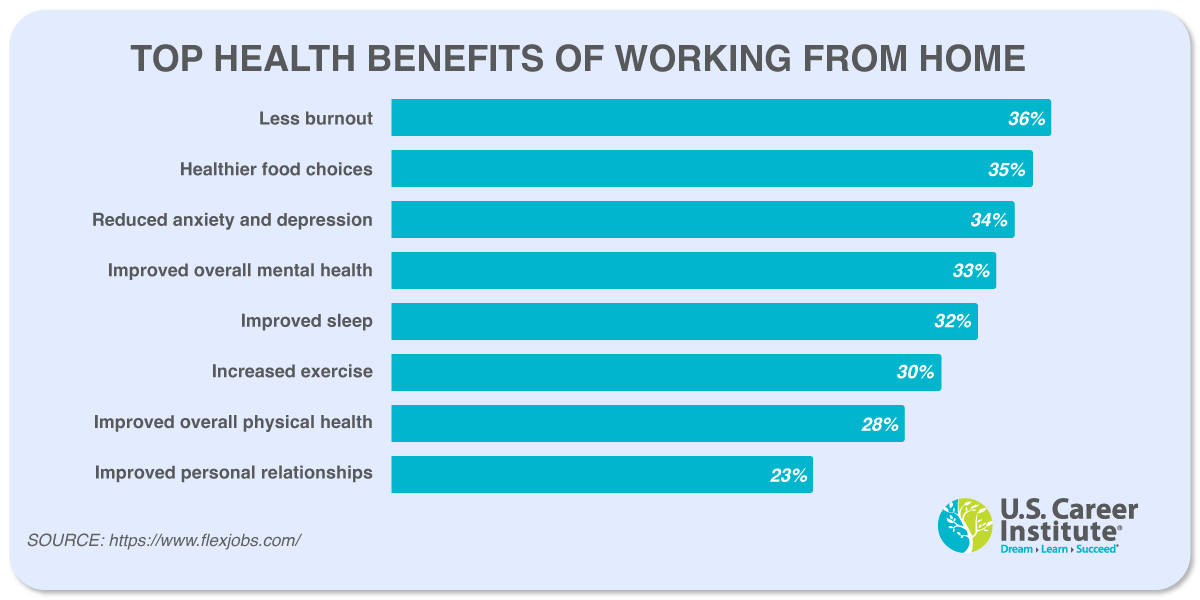
-
Remote workers have the lowest stress levels when compared to hybrid workers and in-office employees.
Just 36% of remote workers say their stress levels have increased in the past year, compared to 55% of hybrid workers and 59% of in-office workers.
-
Fully remote workers and hybrid workers are far more likely to move somewhere new in 2024.
36% of fully remote workers and 44% of hybrid workers planned a move in 2023, compared to just 27% of on-site workers. Flexible remote jobs are allowing remote workers to move to a new city or state, regardless of its proximity to their job.
-
The most common reason remote workers moved was to be closer to family or friends.
28% of remote workers who recently moved did so to be closer to their friends and family. Millennials make up a large portion of remote workers and many are choosing to move closer to family as they start having kids, a trend we foresee continuing through 2024.
Work From Home Demographics
Who is most likely to have a remote job? In this section, we explore the demographics of remote work to see which Americans have embraced the work from home life. You may be surprised to learn which generation is least likely to apply for work from home roles, or where the most remote workers in the U.S. reside.
-
More male employees work from home than female employees.
Among remote workers in the United States, 49.6% identify as male while 46.4% identify as female; 1.3% identify as transgender and the additional 2.8% did not disclose their gender.
-
Nearly two-thirds of all remote workers in the U.S. are white.
The most common race among remote workers is white (64.8%), followed by Hispanic/Latino (13.3%), black (9.6%), Asian (7.6%), and 4.7% of remote workers are two or more races.
-
The age group least likely to apply to remote roles is 20-24 year olds.
Gen Z may have grown up on the Internet but it turns out they still crave social interactions at work. They had the lowest percentage of applications to remote postings by age group: 20-24 (35.5%), 25-29 (39.9%), 30-34 (47.8%), and 35+ (48.8%).
-
The age group with the most remote workers is Millennials.
36.5% of remote workers in the U.S. are between the ages of 25 and 39, 29.8% are 40 to 54 years old, 16% of remote workers ages 55 to 64, 10.7% are 65 or older, and just 6.9% of work from home employees are between the ages of 18 and 24.
-
Colorado has the highest percentage of people who work from home.
37.34% of people in Colorado are working remotely at least one day per week. Maryland’s percentage of people working remotely wasn’t far behind at 37.01%.
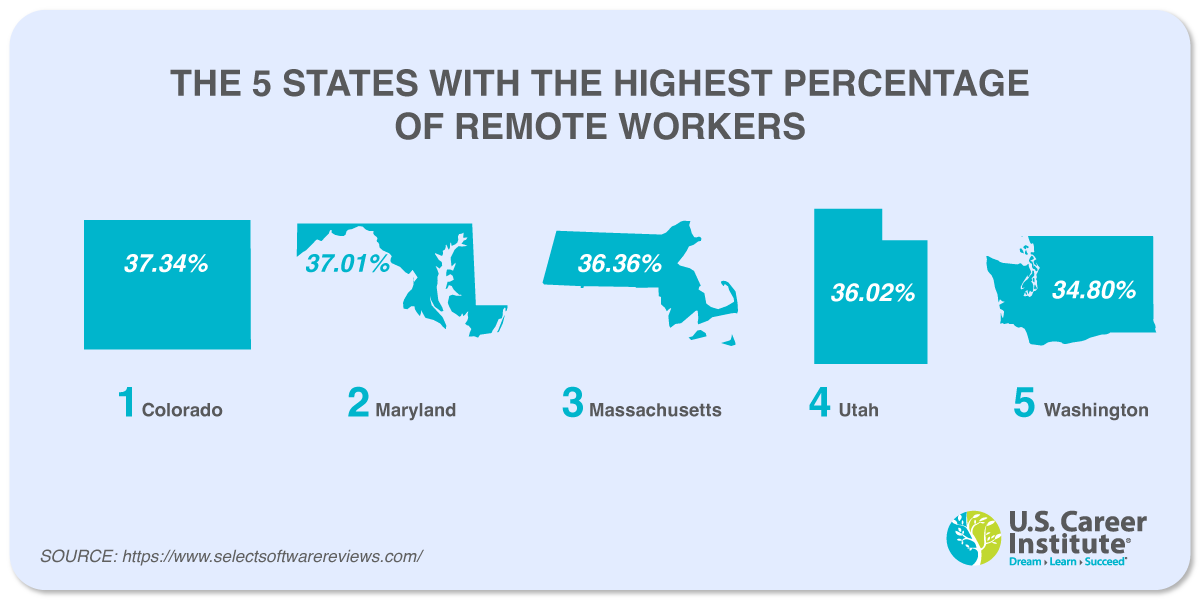
-
Mississippi has the lowest percentage of people who work from home.
Just 11.93% of people in Mississippi work from home at least 1 day per week. Southern states were the least likely to have people working remotely from home.
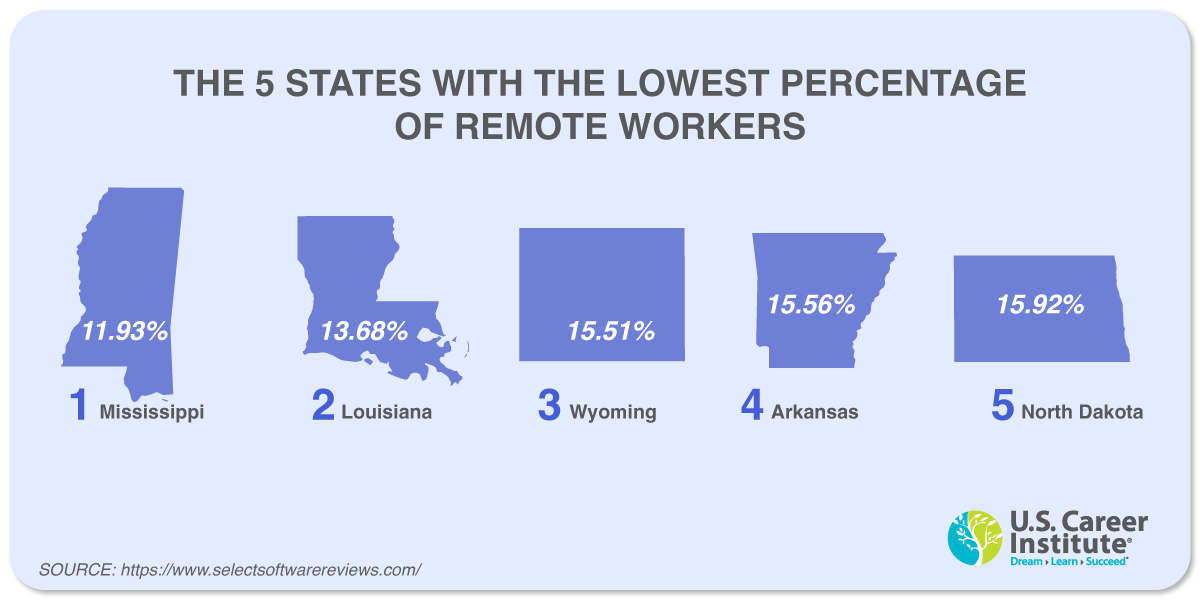
-
Miami is the top-ranking city for remote workers to live in.
According to Forbes, Miami is the best city for remote workers to live in thanks to it nice weather, low taxes, a higher living wage, and many entertainment options to choose from.
-
The U.S. has the world’s highest average number of remote work from home days per week.
Employers in the United States allow their hybrid employees to work remotely an average of 1.9 days each week. The worldwide average is 1.13 days per week.
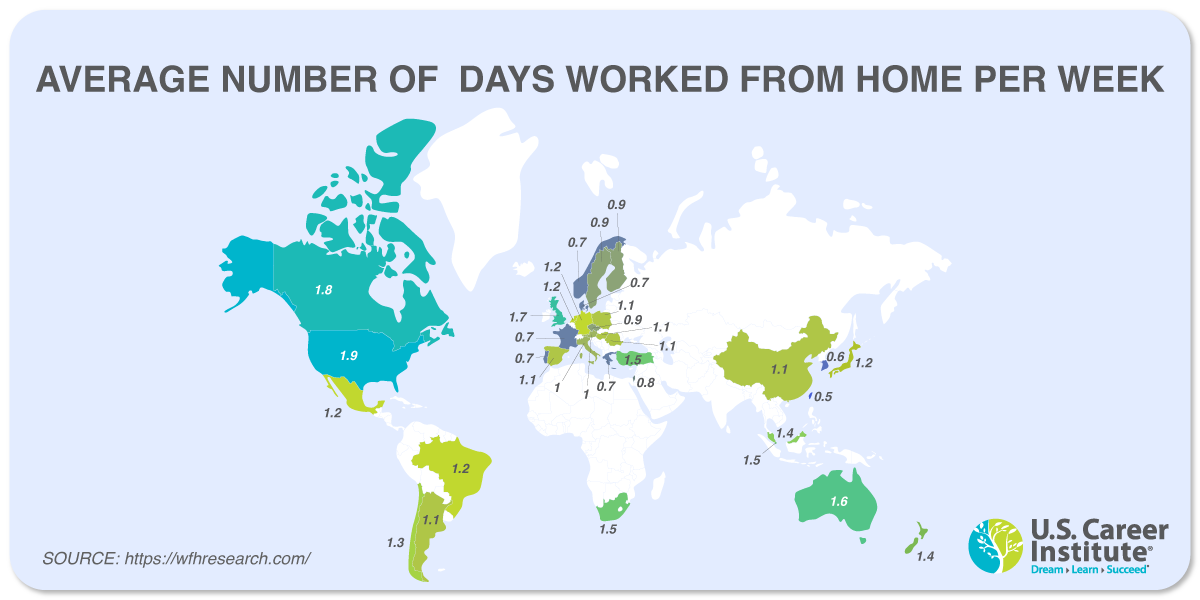
How Employees Feel About Remote Work
As remote work opportunities have grown over the past few years, employees have identified a multitude of benefits that working from home has had on their mental, physical, and financial health. But how do employees feel about remote work when it comes to the everyday aspects of working such as training, collaborating, or being promoted?
-
Over 95% of workers want some form of working from home online.
With so many benefits to remote work, it’s no surprise that a large majority of workers want remote work from home jobs. 54% of people want to work fully remotely, 41% want to work a hybrid schedule, and only 5% of employees want to work in the office full-time.
-
The option to work remotely has become the most important aspect of a job for many.
Nearly two-thirds of employees say that remote work is the most important aspect of a job, ranking even higher than salary, a flexible schedule, and having a good work-life balance. Employee benefits like health insurance, paid time off, and retirement ranked much lower on the list.
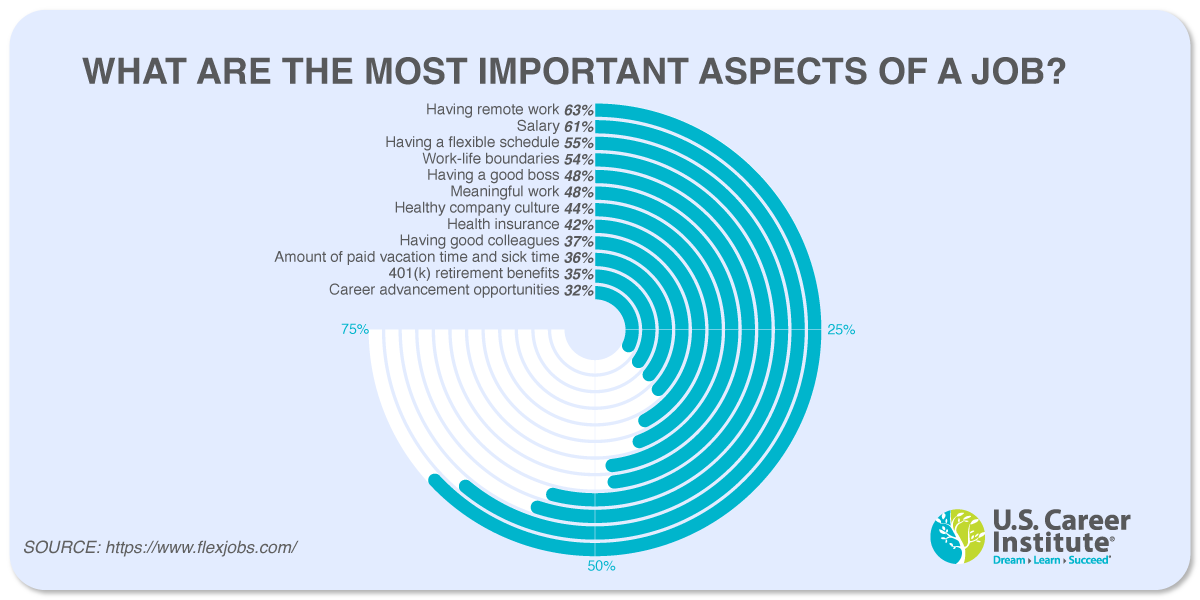
-
71% of remote workers believe that remote work helps the ability to balance their work and personal lives.
While working from home helps a majority of people with their work-life balance, 17% report that remote work neither helps nor hurts their ability to live a balanced life. Another 12% believe that remote work hurts their ability to balance both their work and personal lives.
-
63% of remote workers think that working at home neither helps nor hurts their chances of getting ahead in their jobs.
The number of remote employees who believe working remotely helps their chances and those who think online work from home jobs hurt their chances of getting ahead were split nearly evenly with 18% who believe it helps and 19% who believe it negatively affects their career.
-
28.7% of employees desire a job where they can work remotely at home all of the time.
The majority of employees, nearly one-third surveyed, desire to work remotely all five days of the week. The second-most popular options were working remotely 2 days per week or rarely/never working remote, both of which were the options selected by 18% of workers.
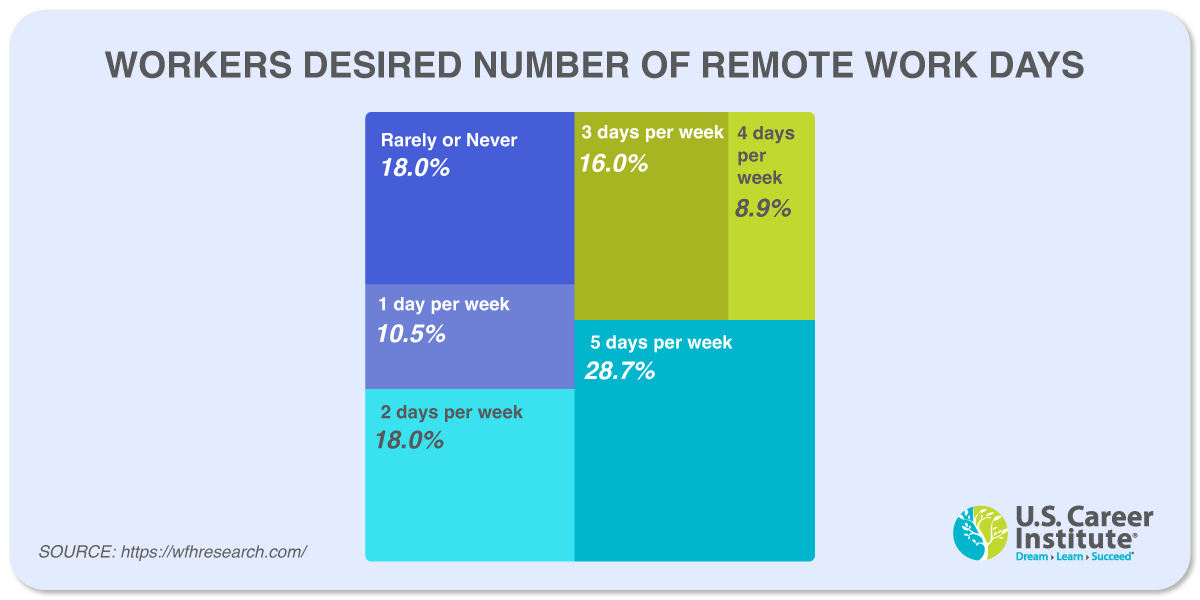
-
14% of employees say they will not go back to working on-site if their employers require it.
Employers are trying to get their employees back in the office but a growing number of workers say that they will not cooperate with this request, instead, they will quit their jobs to pursue a different remote work opportunity.
-
46% of workers find it easier to build relationships with their remote colleagues than their in-office colleagues.
Nearly half of the hybrid workers said that they find it easier to form a relationship with their colleagues while working remotely rather than while working in the office. Roughly one-fourth of those surveyed found it harder to build relationships with remote coworkers or said it made no difference.
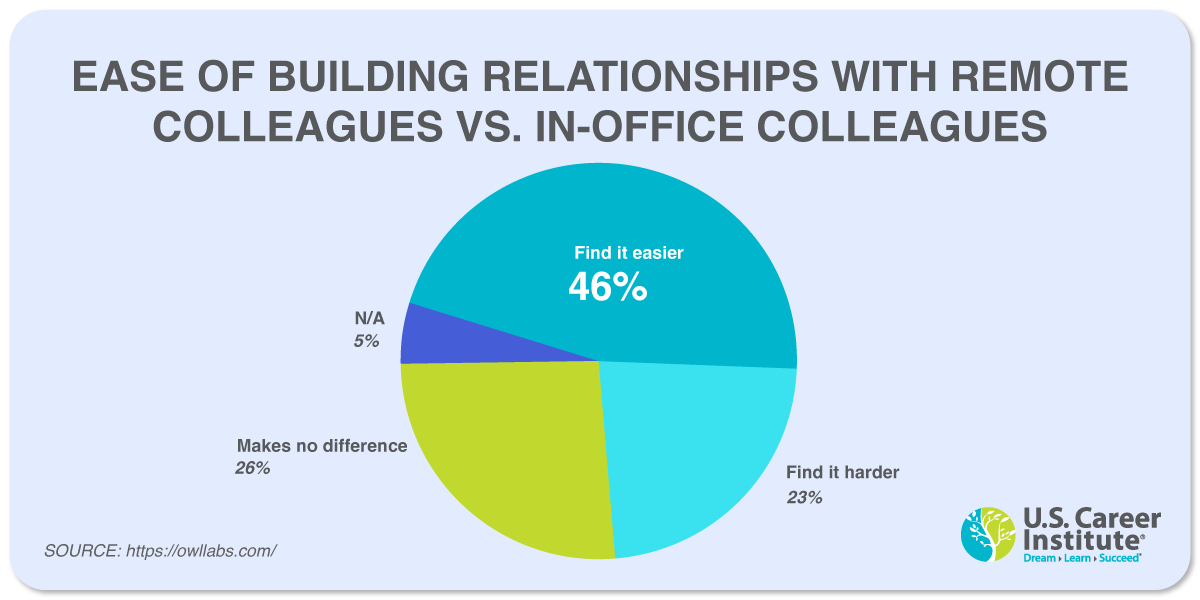
-
36% of remote workers found their onboarding experience at a new remote company confusing.
More than one-third of employees that begin a new job remotely say that in comparison to their in-person counterparts, they felt under-trained, disoriented, and devalued after onboarding with the new company.
-
56% of working professionals know someone who has or will quit their job if they are required to return to office.
Now that employees have gotten a taste of the freedom that comes with working from home, more than half are refusing to lose that freedom by returning to working in an office all the time.
How Employers Feel About Remote Work
Do employers find remote work to be as beneficial as their employees do? While the results are more split among employers when it comes to working remotely, the statistics we found show that more often than not employers are seeing positive outcomes when they allow their employees to work from home part-time or full-time.
-
79% of managers feel their team is more productive when working remotely.
Is working from home more productive? A majority of managers seem to think so! Flexible working hours and not having a daily commute have done wonders for remote work productivity. Just 11% of managers feel that remote work has had no change in their employees’ productivity, and another 10% feel that their remote workers are less productive.
-
The employees who work from home all the time are the most likely to feel trusted by their manager or supervisor.
79% of those who work remotely all of the time say their managers trust them a lot, only 64% of hybrid workers feel that their managers have a lot of trust in them when they work from home.
-
56% of hiring managers believe that working remotely has gone better than expected.
Working remotely has proven to be a successful transition for more than half of managers, while another 35% of managers say that it has gone as expected. However for 9% of managers, the expectations of remote work have been worse than expected.
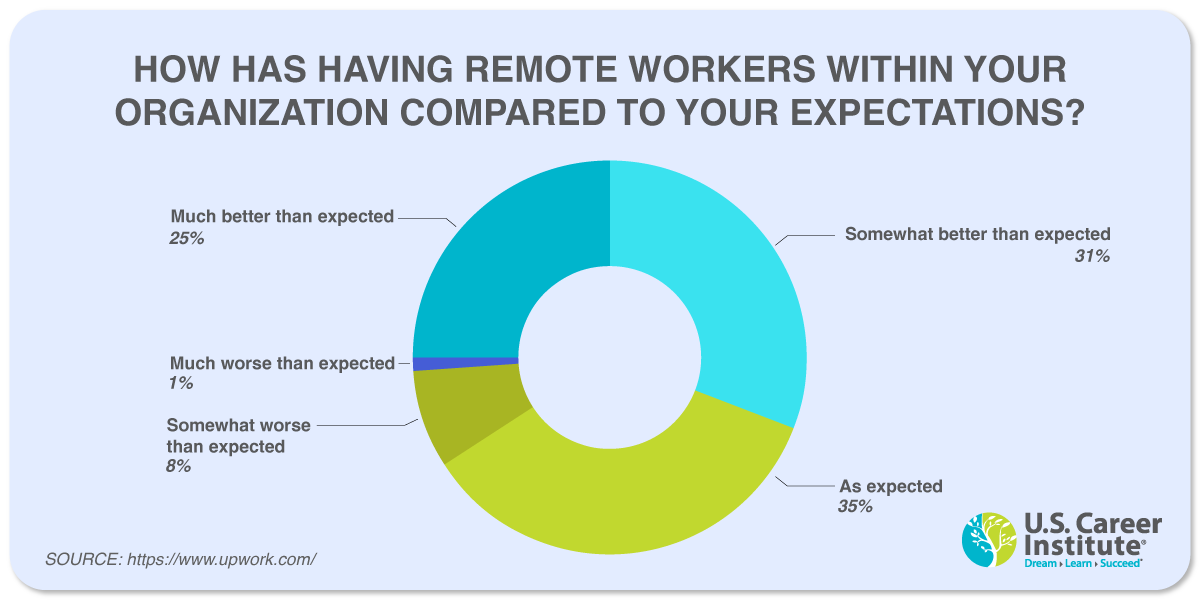
-
Employers allow employees to work from home an average of 2.2 days per week.
The average number of days employers will allow employees to work from home is 2.2 days per week, as long as the employee has a job that can be completed from home.
-
More than half of remote businesses hire independent talent when compared to non-remote businesses.
52.1% of businesses that are primarily remote hire independent professionals, compared to just 38% of non-remote businesses. Utilizing independent professionals allows companies to increase their potential and expand on their offerings.
-
Almost one-third of employers do not offer their employees any remote work opportunities.
32.8% of employers offer zero days of remote work to their employees, while 11% of employers offer 1 day of working from home per week. Just 21.7% of employers allow their employees to work remotely all five days.
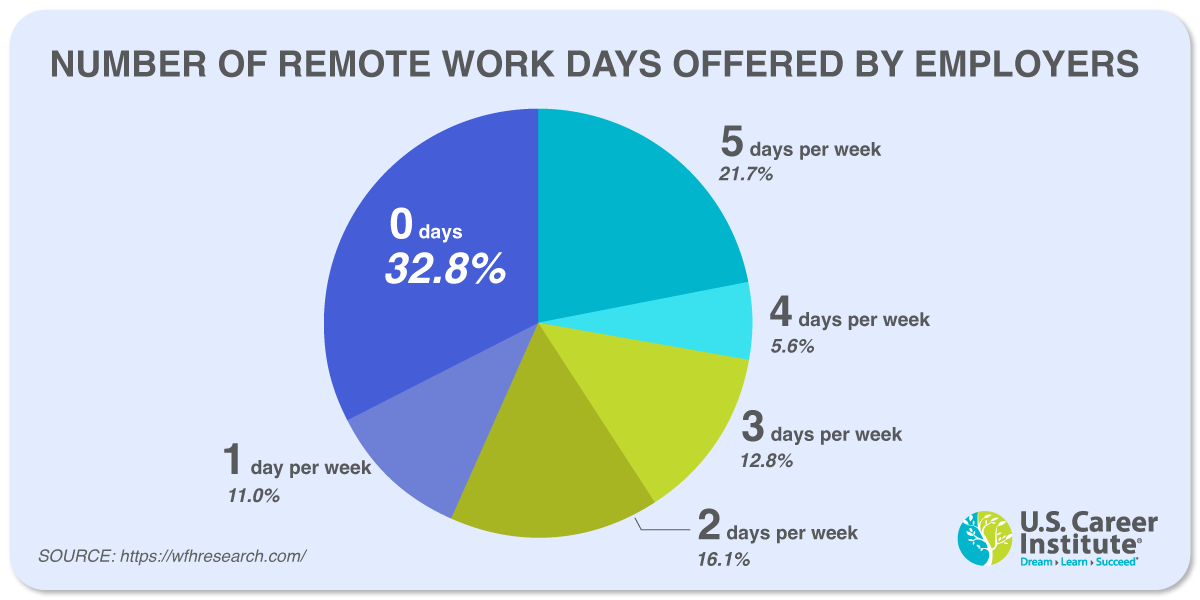
Miscellaneous Remote Work Statistics
Do you have a hankering for more work from home statistics? Then you’re in luck because we’re concluding our list of 50 remote work statistics with even more eye-opening facts about working from home. Keep reading to see how many Americans are estimated to work remotely by 2025, and what the term “coffee badging” means for hybrid workers.
-
26% of U.S. households now have at least one person working remotely a minimum of one day per week.
The number of Americans working remotely has fallen to the lowest level since the pandemic began, but a large portion of them want some form of remote work so we may see this number increase in 2024.
-
The national average work from home salary in the U.S. is $61,178 per year.
How much do remote workers earn? According to ZipRecruiter, the average work from home salary in the U.S. amounts to $29 per hour and $1,176 per week.
-
The most common sectors for remote work are tech, finance, and professional and business services.
Employees in the tech sector work an average of 2.28 days per week from home, the most of any job sector. Employees in the finance and insurance sectors work the second-most days from home with an average of 2.23 days per week.
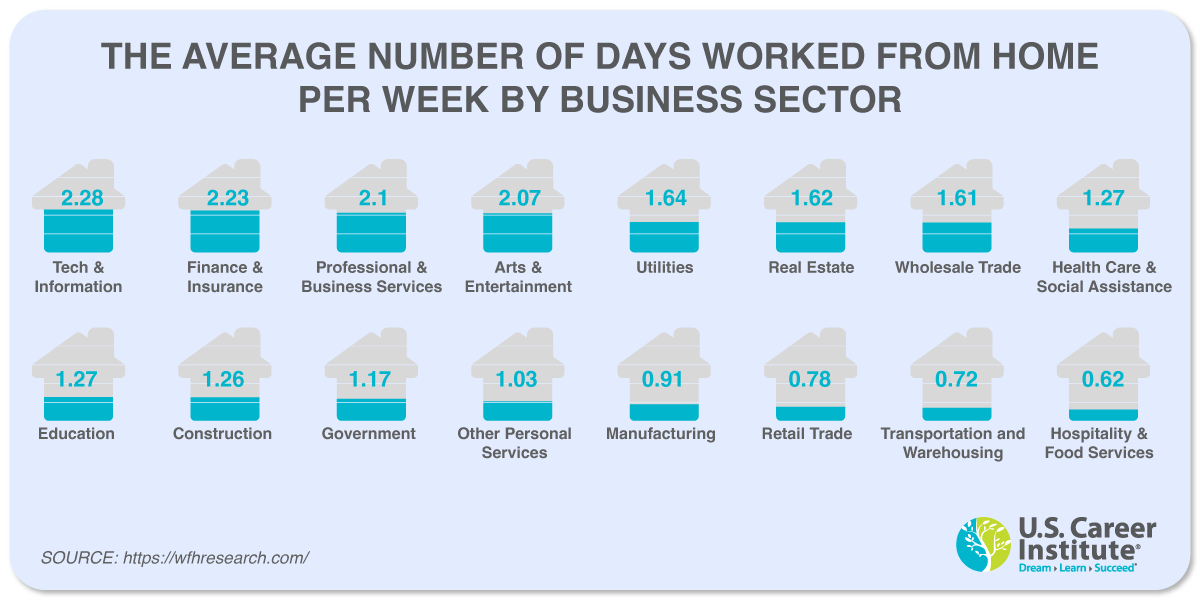
-
75 million U.S. employees have jobs that are compatible with remote work.
It is estimated that 75 million employees in the U.S., or 56% of the non-self-employed workforce, could work from home. Their jobs are compatible with working remotely as they don’t require contact with customers or physical work that needs to be completed on-site; they often have an information component and include work that is done individually rather than in a group.
-
16% of U.S. companies are now fully remote.
We expect to see the number of companies that are fully remote continue to grow, although a large majority (44%) still do not allow their employees to work remotely at all.
-
65% of employees would prefer to work remotely 100% of the time.
Of the employees who prefer some time working in an office, 32% would like to work a hybrid role and 3% would prefer to not work from home at all.
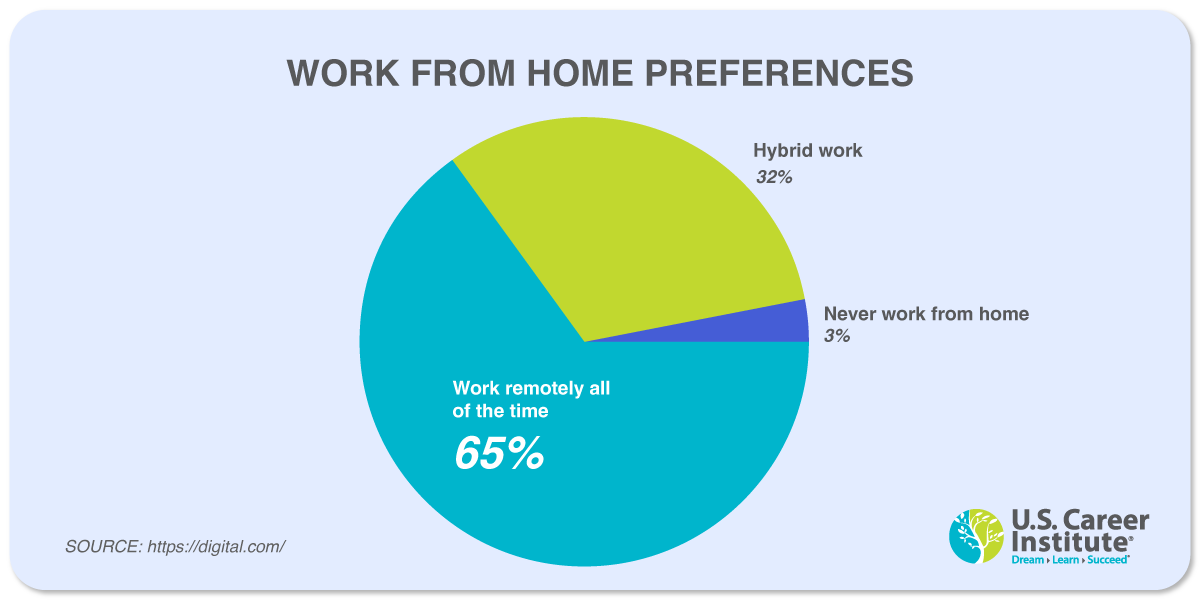
-
58% of hybrid remote workers are “coffee badging” instead of working full days at the office.
What is “coffee badging”? It’s when hybrid employees go to the office for a few hours to show their face before heading home. More than half of hybrid workers admit to having “coffee badged”, and another 8% say they want to try this new work trend.
-
62% of hybrid workers that “coffee badge” are men.
Compared to just 38% of women, meaning you’re far more likely to find female hybrid employees working at the office for a majority of the work day.
-
Roughly 30% of paid full days are worked from home.
Throughout 2023 the percentage of paid full days that were worked from home each month averaged 30% for U.S. workers. While this number has declined since the early days of the pandemic, the percentage of days worked from home remained steady throughout the entirety of 2023.
-
Hybrid workers most commonly work 3 days in the office each week.
Nearly half of all hybrid workers are in the office 3 days a week. The number of hybrid workers that are in-office for 2 or 4 days each week is nearly equal while only 7% of hybrid workers are in the office just 1 day each week.
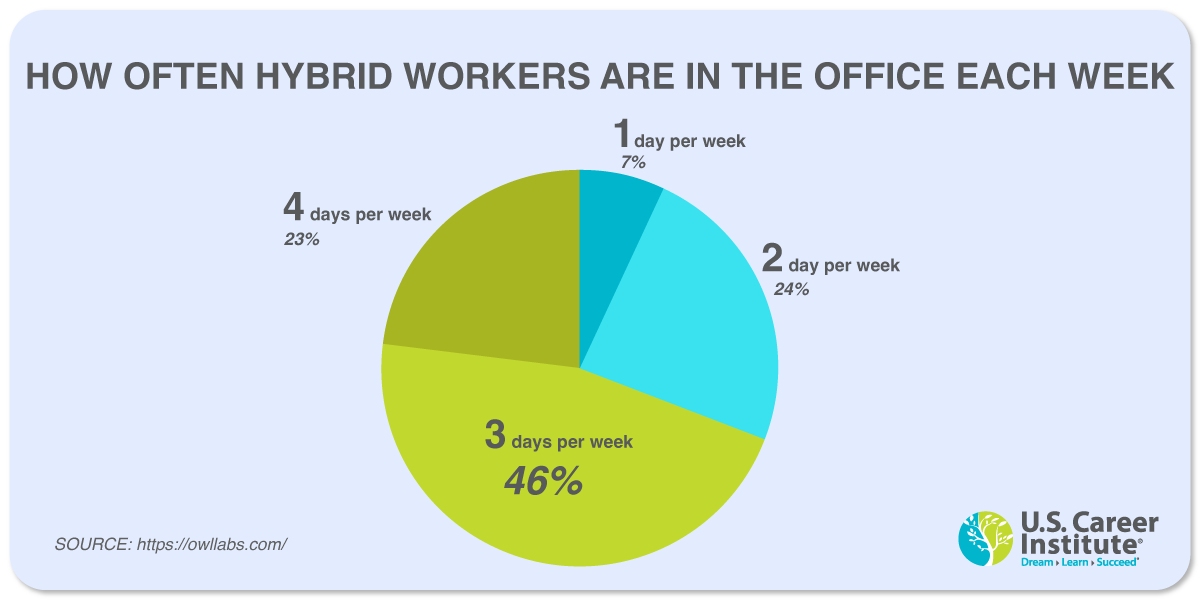
-
The larger the company, the fewer days per week on average the employees work in the office.
Workers employed by companies with thousands of employees were often found to work 1-2 fewer days in the office each week than their much smaller counterparts. For example, companies in professional services with more than 25,000 employees worked in-office 2-2.5 days each week while the firms with 2-49 employees were in-office 3.5-4 days per week.
-
Senior-level employees work from home more than Junior-level employees.
46% of junior-level employees were found to work in the office 5 days per week while only 32% of employees in senior-level positions work in the office all of the time.
-
35% of workers with jobs that can be done remotely work from home all of the time now.
According to Pew Research, more than one-third of Americans that have a job that allows them to work remotely from home are choosing to do so 100% of the time. Before the pandemic, just 7% of the population would work online from home.
-
Employees with higher levels of education have more options for remote work.
Employees with advanced degrees have the most options for remote work, with 45% of full-time remote jobs available to them, and 31% of part-time remote jobs. Workers who have obtained less than a high school degree only qualify for 32% of full-time work from home jobs and 21% of part-time work from home jobs.

-
The most common activity Americans do while working from home is scrolling social media.
74.7% of U.S. workers admit to scrolling social media while they’re on the clock at home. The second most common activity was doing household chores (71.6%), followed by shopping online (69.9%), watching TV/movies (52.9%), and running errands (37.4%).
-
By 2025 up to 36.2 million Americans will be working remotely.
It has been predicted that by the end of 2025, up to 14% of the adult population in the U.S. will have remote work from home jobs. This will result in a five-fold increase since before the pandemic when just 7 million Americans were working from home online.
Which of these 50 work from home statistics did you find to be the most eye-opening? We were surprised to learn how many thousands of dollars remote workers AND their companies can save each year by switching to remote work; as well as the large cut in greenhouse gas emissions when remote workers stop having to commute to an office five days a week.
If you’re looking for a fresh start with a remote job, check out our list of the best jobs you can work remotely. Medical Billing is a good option and can be achieved through our Online Medical Billing Course which allows you to study at any time or place. Accounting is another great career that can be done remotely, earn an Associate Degree in Accounting or a certificate for Accounting Services with one of our online programs. Are you ready to join the U.S. Career Institute and make your work from home dreams a reality!?
Data Sources:
-
[1] https://www.axios.com/2023/01/24/remote-work-saved-workers-72-minutes-per-day-study-finds
-
[2] https://www.pnas.org/doi/full/10.1073/pnas.2304099120
-
[3, 19] https://wfhresearch.com/wp-content/uploads/2023/06/GSWA-2023.pdf
-
[4, 25] https://digital.com/why-people-want-to-work-from-home/
-
[5] https://lemon.io/blog/research-startups-save-up-to-10601000-yearly-on-remote-workers/
-
[6] https://www.flexjobs.com/blog/post/does-working-remotely-save-you-money/
-
[9, 26, 29, 41, 42, 44] https://owllabs.com/state-of-hybrid-work/2023
-
[10,11] https://www.apartmentlist.com/research/remote-worker-migration-expected-to-persist-in-2023
-
[12, 13, 15, 16, 17] https://www.selectsoftwarereviews.com/blog/work-from-home-hotspots-usa
-
[14, 32, 34, 37, 43] https://wfhresearch.com/wp-content/uploads/2024/01/WFHResearch_updates_January2024.pdf
-
[18] https://www.forbes.com/advisor/business/best-cities-remote-workers/
-
[22, 23, 30, 47] https://www.pewresearch.org/short-reads/2023/03/30/about-a-third-of-us-workers-who-can-work-from-home-do-so-all-the-time/
-
[24] https://hrnews.co.uk/20-24-year-olds-are-the-age-group-least-likely-to-apply-to-remote-roles/
-
[27] https://finance.yahoo.com/news/bosses-fed-remote-4-main-193500794.html
-
[28] https://www.flexjobs.com/blog/post/remote-work-statistics/
-
[33] https://www.upwork.com/research/report-on-the-growth-of-remote-teams
-
[35] https://www.businessinsider.com/remote-work-from-home-return-to-office-americans-employment-wfh-2023-10
-
[36] https://www.ziprecruiter.com/Salaries/Work-From-Home-Salary#Weekly
-
[38] https://globalworkplaceanalytics.com/how-many-people-could-work-from-home
-
[39, 50] https://www.zippia.com/advice/remote-work-statistics/
-
[40] https://www.flexjobs.com/blog/post/top-states-with-the-most-remote-jobs/
-
[45,46] https://www.mckinsey.com/mgi/our-research/empty-spaces-and-hybrid-places-chapter-1#/
-
[48] https://www.statista.com/statistics/1320088/availability-remote-work-by-education-us/
-
[49] https://upgradedpoints.com/news/what-are-remote-workers-doing-on-the-clock/
